MBA502: Diversity in Workplace Presentation Analysis
VerifiedAdded on 2022/11/13
|10
|1401
|270
Presentation
AI Summary
This presentation provides an analysis of emotional intelligence and diversity within the workplace, focusing on Woolworths as a case study. The presentation begins with a brief introduction, followed by an overview of Woolworths and the rationale for its selection. It then delves into the company's diversity-related initiatives, such as its commitment to gender parity, equal pay, and initiatives to include Indigenous team members. The presentation draws on various sources, including academic research and company reports, to highlight Woolworths' strategies and their impact. A critique of these initiatives is provided, evaluating their effectiveness in fostering an inclusive culture. The presentation concludes with recommendations for further improvements, emphasizing the importance of continuous efforts to promote diversity and emotional intelligence in the workplace. The analysis covers the company's Employment Parity Initiative and its goal to provide equal representation to all employees, irrespective of their background. The presentation emphasizes the importance of diversity for creating a positive work environment.
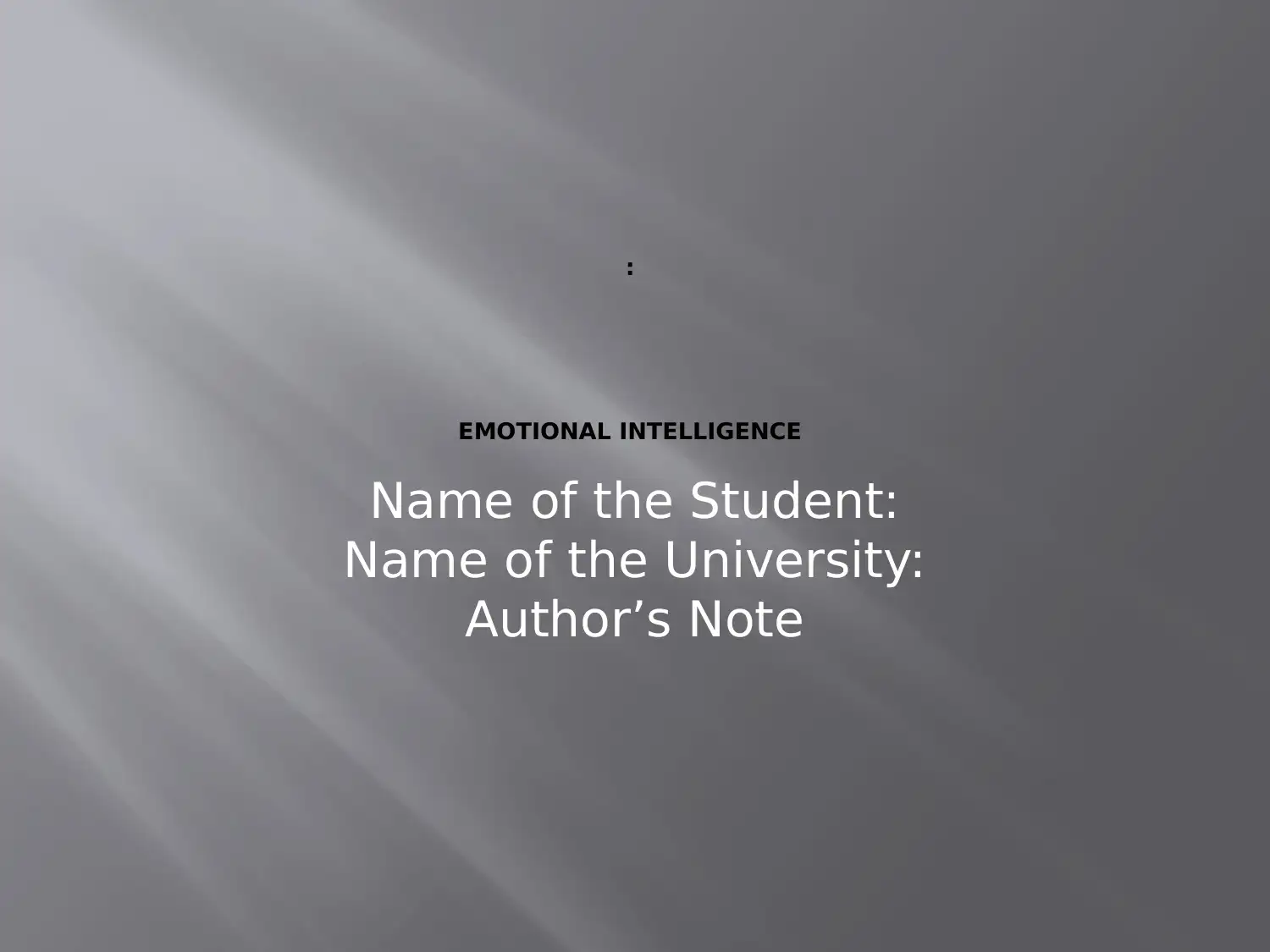
:
EMOTIONAL INTELLIGENCE
Name of the Student:
Name of the University:
Author’s Note
EMOTIONAL INTELLIGENCE
Name of the Student:
Name of the University:
Author’s Note
Paraphrase This Document
Need a fresh take? Get an instant paraphrase of this document with our AI Paraphraser
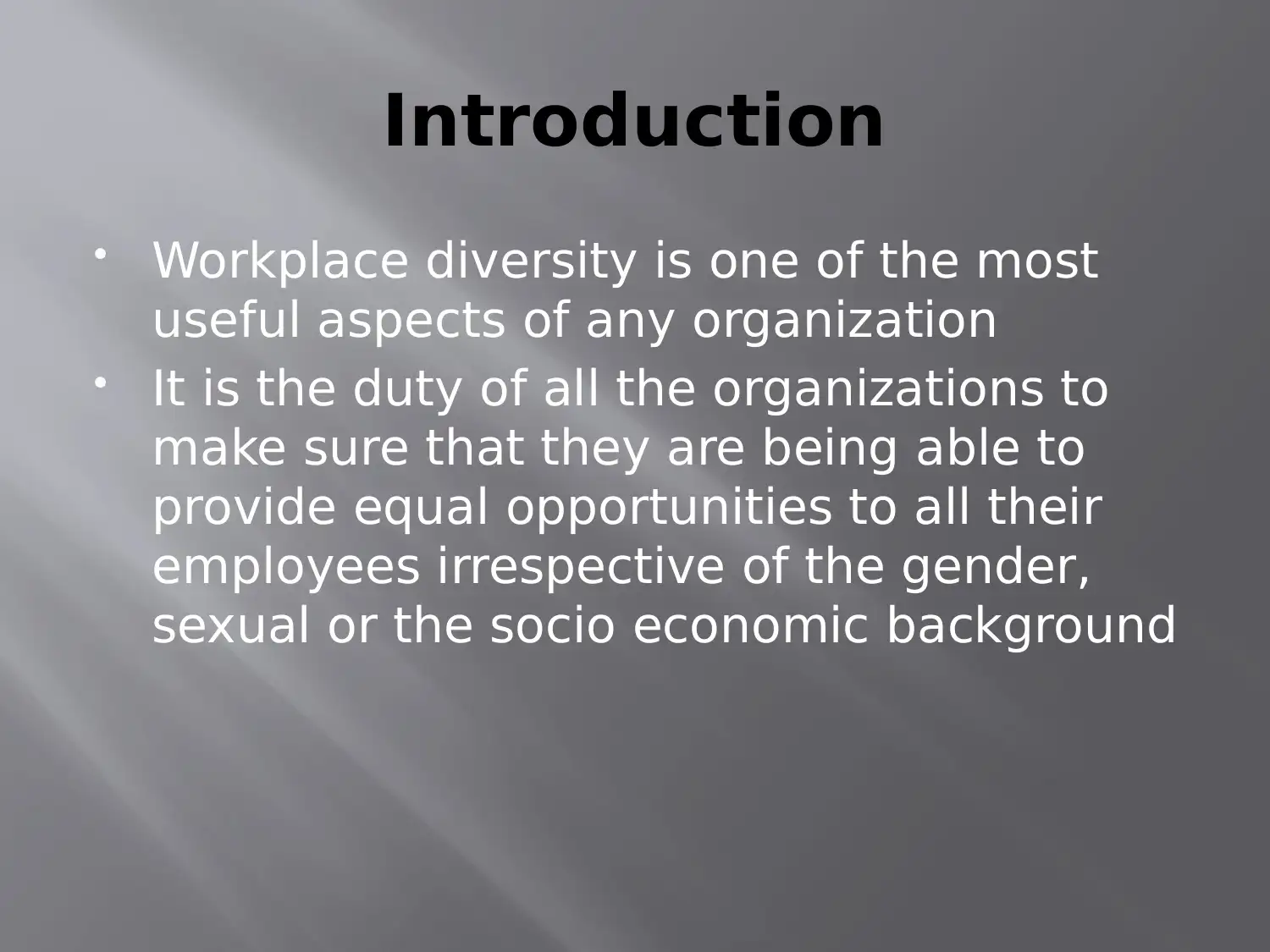
Introduction
Workplace diversity is one of the most
useful aspects of any organization
It is the duty of all the organizations to
make sure that they are being able to
provide equal opportunities to all their
employees irrespective of the gender,
sexual or the socio economic background
Workplace diversity is one of the most
useful aspects of any organization
It is the duty of all the organizations to
make sure that they are being able to
provide equal opportunities to all their
employees irrespective of the gender,
sexual or the socio economic background
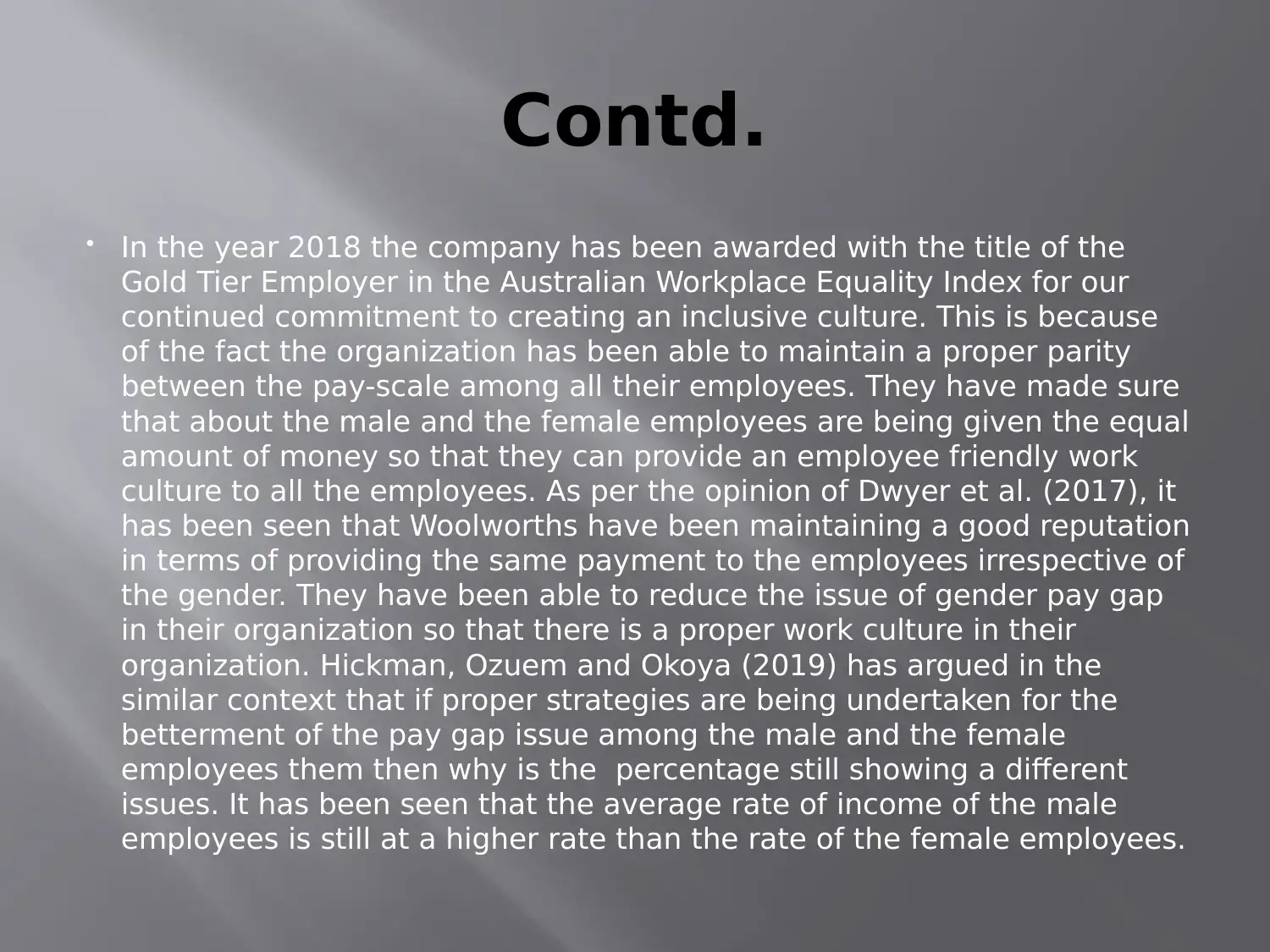
Contd.
In the year 2018 the company has been awarded with the title of the
Gold Tier Employer in the Australian Workplace Equality Index for our
continued commitment to creating an inclusive culture. This is because
of the fact the organization has been able to maintain a proper parity
between the pay-scale among all their employees. They have made sure
that about the male and the female employees are being given the equal
amount of money so that they can provide an employee friendly work
culture to all the employees. As per the opinion of Dwyer et al. (2017), it
has been seen that Woolworths have been maintaining a good reputation
in terms of providing the same payment to the employees irrespective of
the gender. They have been able to reduce the issue of gender pay gap
in their organization so that there is a proper work culture in their
organization. Hickman, Ozuem and Okoya (2019) has argued in the
similar context that if proper strategies are being undertaken for the
betterment of the pay gap issue among the male and the female
employees them then why is the percentage still showing a different
issues. It has been seen that the average rate of income of the male
employees is still at a higher rate than the rate of the female employees.
In the year 2018 the company has been awarded with the title of the
Gold Tier Employer in the Australian Workplace Equality Index for our
continued commitment to creating an inclusive culture. This is because
of the fact the organization has been able to maintain a proper parity
between the pay-scale among all their employees. They have made sure
that about the male and the female employees are being given the equal
amount of money so that they can provide an employee friendly work
culture to all the employees. As per the opinion of Dwyer et al. (2017), it
has been seen that Woolworths have been maintaining a good reputation
in terms of providing the same payment to the employees irrespective of
the gender. They have been able to reduce the issue of gender pay gap
in their organization so that there is a proper work culture in their
organization. Hickman, Ozuem and Okoya (2019) has argued in the
similar context that if proper strategies are being undertaken for the
betterment of the pay gap issue among the male and the female
employees them then why is the percentage still showing a different
issues. It has been seen that the average rate of income of the male
employees is still at a higher rate than the rate of the female employees.
⊘ This is a preview!⊘
Do you want full access?
Subscribe today to unlock all pages.

Trusted by 1+ million students worldwide
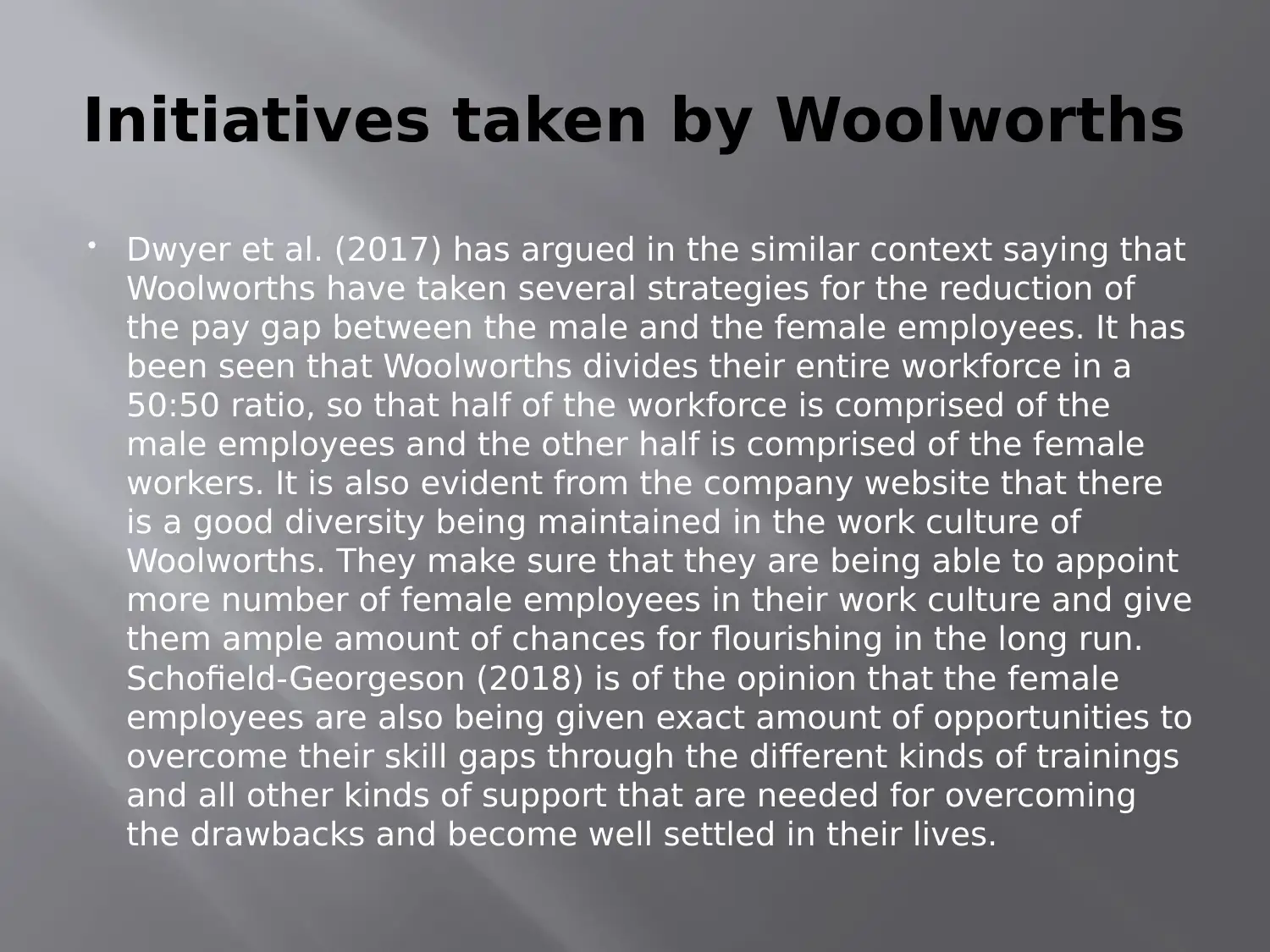
Initiatives taken by Woolworths
Dwyer et al. (2017) has argued in the similar context saying that
Woolworths have taken several strategies for the reduction of
the pay gap between the male and the female employees. It has
been seen that Woolworths divides their entire workforce in a
50:50 ratio, so that half of the workforce is comprised of the
male employees and the other half is comprised of the female
workers. It is also evident from the company website that there
is a good diversity being maintained in the work culture of
Woolworths. They make sure that they are being able to appoint
more number of female employees in their work culture and give
them ample amount of chances for flourishing in the long run.
Schofield-Georgeson (2018) is of the opinion that the female
employees are also being given exact amount of opportunities to
overcome their skill gaps through the different kinds of trainings
and all other kinds of support that are needed for overcoming
the drawbacks and become well settled in their lives.
Dwyer et al. (2017) has argued in the similar context saying that
Woolworths have taken several strategies for the reduction of
the pay gap between the male and the female employees. It has
been seen that Woolworths divides their entire workforce in a
50:50 ratio, so that half of the workforce is comprised of the
male employees and the other half is comprised of the female
workers. It is also evident from the company website that there
is a good diversity being maintained in the work culture of
Woolworths. They make sure that they are being able to appoint
more number of female employees in their work culture and give
them ample amount of chances for flourishing in the long run.
Schofield-Georgeson (2018) is of the opinion that the female
employees are also being given exact amount of opportunities to
overcome their skill gaps through the different kinds of trainings
and all other kinds of support that are needed for overcoming
the drawbacks and become well settled in their lives.
Paraphrase This Document
Need a fresh take? Get an instant paraphrase of this document with our AI Paraphraser
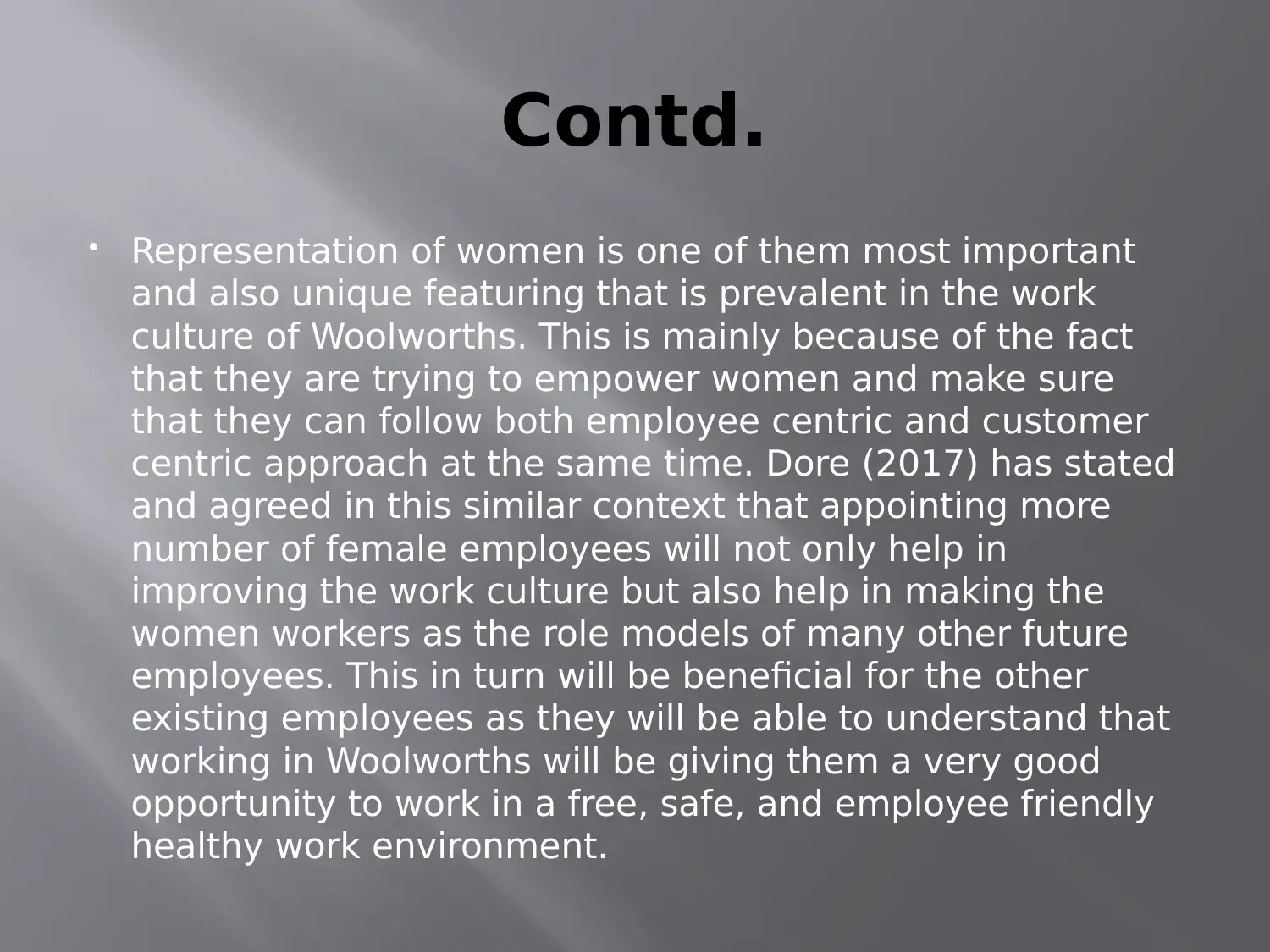
Contd.
Representation of women is one of them most important
and also unique featuring that is prevalent in the work
culture of Woolworths. This is mainly because of the fact
that they are trying to empower women and make sure
that they can follow both employee centric and customer
centric approach at the same time. Dore (2017) has stated
and agreed in this similar context that appointing more
number of female employees will not only help in
improving the work culture but also help in making the
women workers as the role models of many other future
employees. This in turn will be beneficial for the other
existing employees as they will be able to understand that
working in Woolworths will be giving them a very good
opportunity to work in a free, safe, and employee friendly
healthy work environment.
Representation of women is one of them most important
and also unique featuring that is prevalent in the work
culture of Woolworths. This is mainly because of the fact
that they are trying to empower women and make sure
that they can follow both employee centric and customer
centric approach at the same time. Dore (2017) has stated
and agreed in this similar context that appointing more
number of female employees will not only help in
improving the work culture but also help in making the
women workers as the role models of many other future
employees. This in turn will be beneficial for the other
existing employees as they will be able to understand that
working in Woolworths will be giving them a very good
opportunity to work in a free, safe, and employee friendly
healthy work environment.
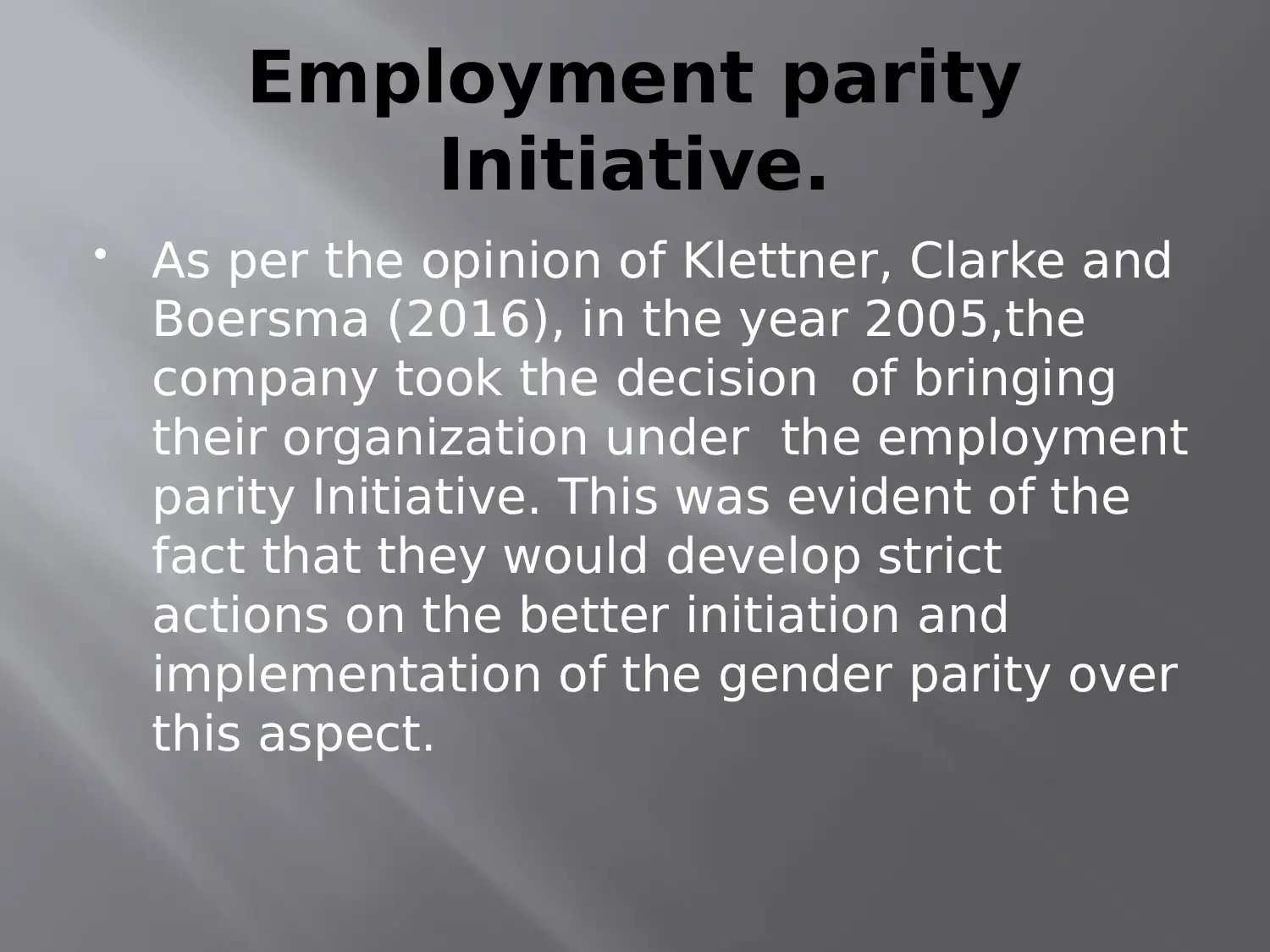
Employment parity
Initiative.
As per the opinion of Klettner, Clarke and
Boersma (2016), in the year 2005,the
company took the decision of bringing
their organization under the employment
parity Initiative. This was evident of the
fact that they would develop strict
actions on the better initiation and
implementation of the gender parity over
this aspect.
Initiative.
As per the opinion of Klettner, Clarke and
Boersma (2016), in the year 2005,the
company took the decision of bringing
their organization under the employment
parity Initiative. This was evident of the
fact that they would develop strict
actions on the better initiation and
implementation of the gender parity over
this aspect.
⊘ This is a preview!⊘
Do you want full access?
Subscribe today to unlock all pages.

Trusted by 1+ million students worldwide
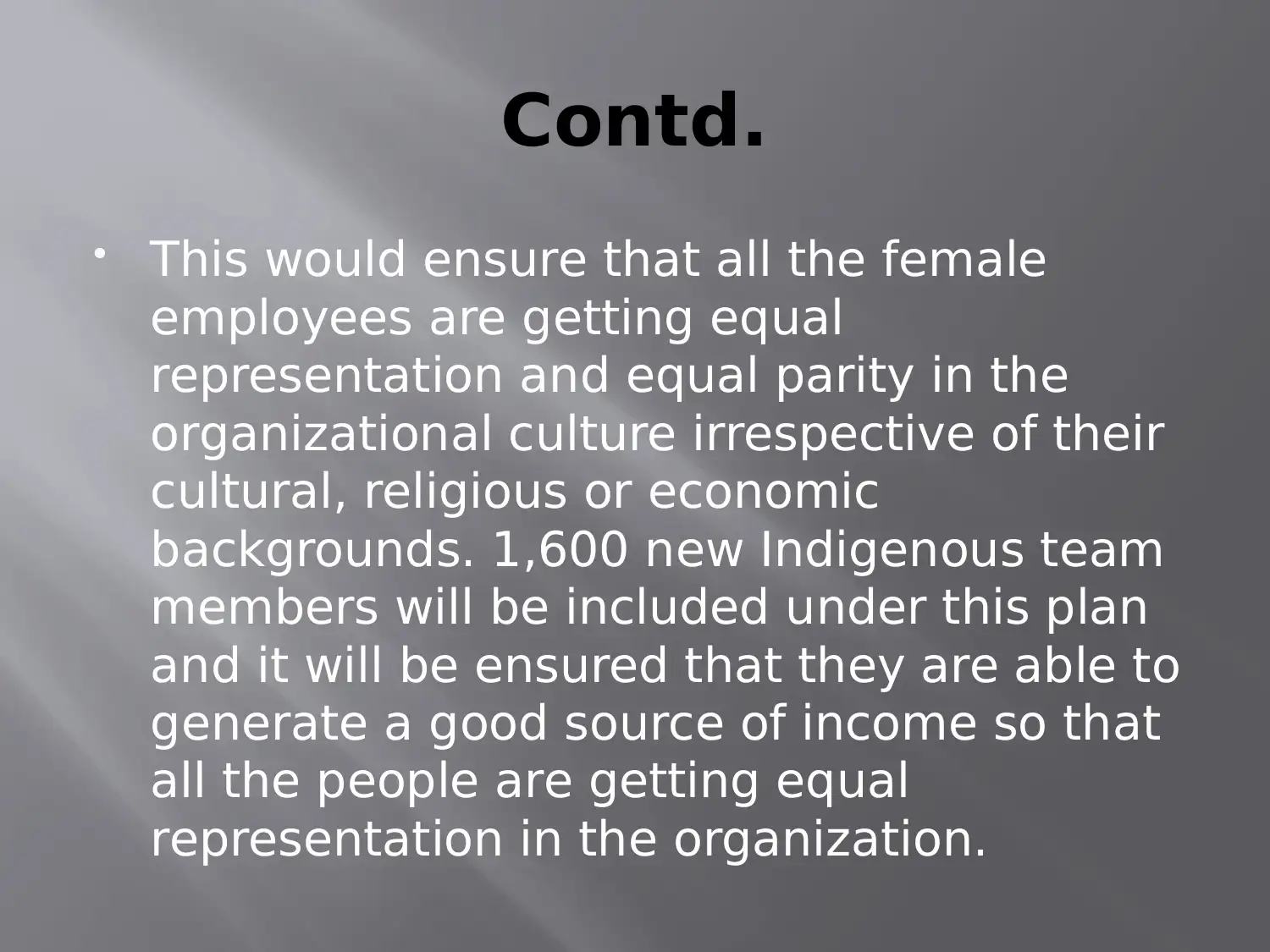
Contd.
This would ensure that all the female
employees are getting equal
representation and equal parity in the
organizational culture irrespective of their
cultural, religious or economic
backgrounds. 1,600 new Indigenous team
members will be included under this plan
and it will be ensured that they are able to
generate a good source of income so that
all the people are getting equal
representation in the organization.
This would ensure that all the female
employees are getting equal
representation and equal parity in the
organizational culture irrespective of their
cultural, religious or economic
backgrounds. 1,600 new Indigenous team
members will be included under this plan
and it will be ensured that they are able to
generate a good source of income so that
all the people are getting equal
representation in the organization.
Paraphrase This Document
Need a fresh take? Get an instant paraphrase of this document with our AI Paraphraser
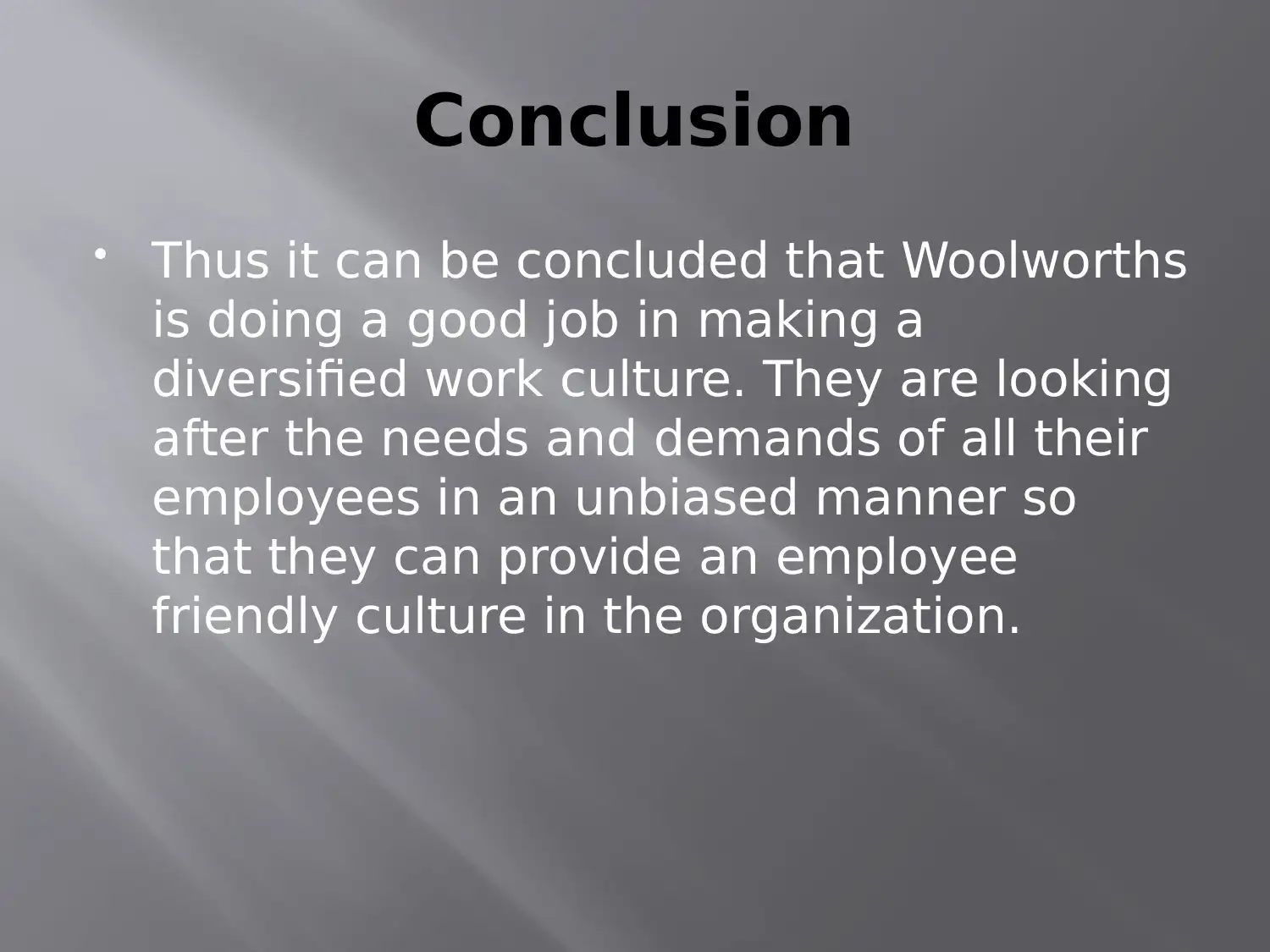
Conclusion
Thus it can be concluded that Woolworths
is doing a good job in making a
diversified work culture. They are looking
after the needs and demands of all their
employees in an unbiased manner so
that they can provide an employee
friendly culture in the organization.
Thus it can be concluded that Woolworths
is doing a good job in making a
diversified work culture. They are looking
after the needs and demands of all their
employees in an unbiased manner so
that they can provide an employee
friendly culture in the organization.
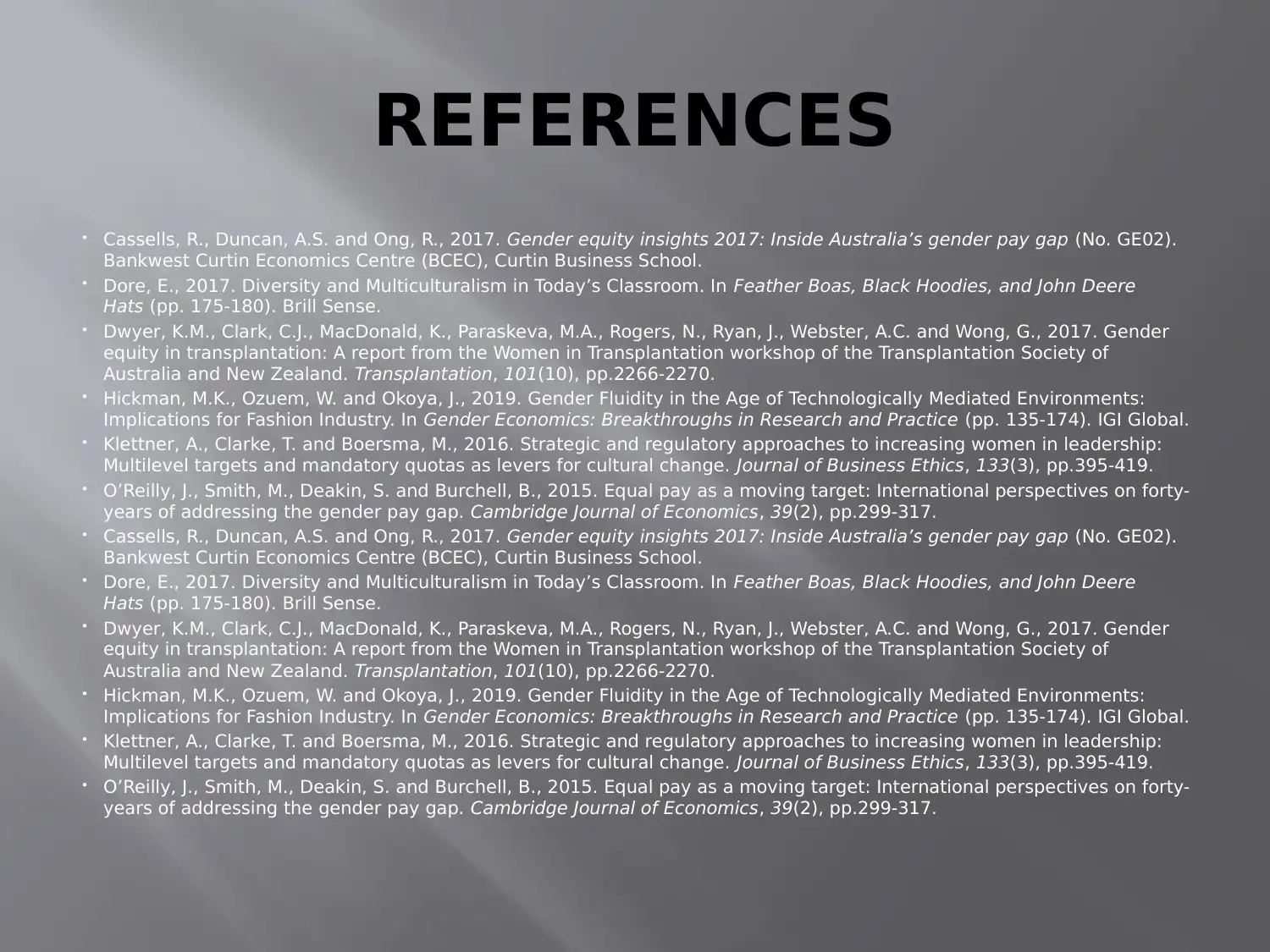
REFERENCES
Cassells, R., Duncan, A.S. and Ong, R., 2017. Gender equity insights 2017: Inside Australia’s gender pay gap (No. GE02).
Bankwest Curtin Economics Centre (BCEC), Curtin Business School.
Dore, E., 2017. Diversity and Multiculturalism in Today’s Classroom. In Feather Boas, Black Hoodies, and John Deere
Hats (pp. 175-180). Brill Sense.
Dwyer, K.M., Clark, C.J., MacDonald, K., Paraskeva, M.A., Rogers, N., Ryan, J., Webster, A.C. and Wong, G., 2017. Gender
equity in transplantation: A report from the Women in Transplantation workshop of the Transplantation Society of
Australia and New Zealand. Transplantation, 101(10), pp.2266-2270.
Hickman, M.K., Ozuem, W. and Okoya, J., 2019. Gender Fluidity in the Age of Technologically Mediated Environments:
Implications for Fashion Industry. In Gender Economics: Breakthroughs in Research and Practice (pp. 135-174). IGI Global.
Klettner, A., Clarke, T. and Boersma, M., 2016. Strategic and regulatory approaches to increasing women in leadership:
Multilevel targets and mandatory quotas as levers for cultural change. Journal of Business Ethics, 133(3), pp.395-419.
O’Reilly, J., Smith, M., Deakin, S. and Burchell, B., 2015. Equal pay as a moving target: International perspectives on forty-
years of addressing the gender pay gap. Cambridge Journal of Economics, 39(2), pp.299-317.
Cassells, R., Duncan, A.S. and Ong, R., 2017. Gender equity insights 2017: Inside Australia’s gender pay gap (No. GE02).
Bankwest Curtin Economics Centre (BCEC), Curtin Business School.
Dore, E., 2017. Diversity and Multiculturalism in Today’s Classroom. In Feather Boas, Black Hoodies, and John Deere
Hats (pp. 175-180). Brill Sense.
Dwyer, K.M., Clark, C.J., MacDonald, K., Paraskeva, M.A., Rogers, N., Ryan, J., Webster, A.C. and Wong, G., 2017. Gender
equity in transplantation: A report from the Women in Transplantation workshop of the Transplantation Society of
Australia and New Zealand. Transplantation, 101(10), pp.2266-2270.
Hickman, M.K., Ozuem, W. and Okoya, J., 2019. Gender Fluidity in the Age of Technologically Mediated Environments:
Implications for Fashion Industry. In Gender Economics: Breakthroughs in Research and Practice (pp. 135-174). IGI Global.
Klettner, A., Clarke, T. and Boersma, M., 2016. Strategic and regulatory approaches to increasing women in leadership:
Multilevel targets and mandatory quotas as levers for cultural change. Journal of Business Ethics, 133(3), pp.395-419.
O’Reilly, J., Smith, M., Deakin, S. and Burchell, B., 2015. Equal pay as a moving target: International perspectives on forty-
years of addressing the gender pay gap. Cambridge Journal of Economics, 39(2), pp.299-317.
Cassells, R., Duncan, A.S. and Ong, R., 2017. Gender equity insights 2017: Inside Australia’s gender pay gap (No. GE02).
Bankwest Curtin Economics Centre (BCEC), Curtin Business School.
Dore, E., 2017. Diversity and Multiculturalism in Today’s Classroom. In Feather Boas, Black Hoodies, and John Deere
Hats (pp. 175-180). Brill Sense.
Dwyer, K.M., Clark, C.J., MacDonald, K., Paraskeva, M.A., Rogers, N., Ryan, J., Webster, A.C. and Wong, G., 2017. Gender
equity in transplantation: A report from the Women in Transplantation workshop of the Transplantation Society of
Australia and New Zealand. Transplantation, 101(10), pp.2266-2270.
Hickman, M.K., Ozuem, W. and Okoya, J., 2019. Gender Fluidity in the Age of Technologically Mediated Environments:
Implications for Fashion Industry. In Gender Economics: Breakthroughs in Research and Practice (pp. 135-174). IGI Global.
Klettner, A., Clarke, T. and Boersma, M., 2016. Strategic and regulatory approaches to increasing women in leadership:
Multilevel targets and mandatory quotas as levers for cultural change. Journal of Business Ethics, 133(3), pp.395-419.
O’Reilly, J., Smith, M., Deakin, S. and Burchell, B., 2015. Equal pay as a moving target: International perspectives on forty-
years of addressing the gender pay gap. Cambridge Journal of Economics, 39(2), pp.299-317.
Cassells, R., Duncan, A.S. and Ong, R., 2017. Gender equity insights 2017: Inside Australia’s gender pay gap (No. GE02).
Bankwest Curtin Economics Centre (BCEC), Curtin Business School.
Dore, E., 2017. Diversity and Multiculturalism in Today’s Classroom. In Feather Boas, Black Hoodies, and John Deere
Hats (pp. 175-180). Brill Sense.
Dwyer, K.M., Clark, C.J., MacDonald, K., Paraskeva, M.A., Rogers, N., Ryan, J., Webster, A.C. and Wong, G., 2017. Gender
equity in transplantation: A report from the Women in Transplantation workshop of the Transplantation Society of
Australia and New Zealand. Transplantation, 101(10), pp.2266-2270.
Hickman, M.K., Ozuem, W. and Okoya, J., 2019. Gender Fluidity in the Age of Technologically Mediated Environments:
Implications for Fashion Industry. In Gender Economics: Breakthroughs in Research and Practice (pp. 135-174). IGI Global.
Klettner, A., Clarke, T. and Boersma, M., 2016. Strategic and regulatory approaches to increasing women in leadership:
Multilevel targets and mandatory quotas as levers for cultural change. Journal of Business Ethics, 133(3), pp.395-419.
O’Reilly, J., Smith, M., Deakin, S. and Burchell, B., 2015. Equal pay as a moving target: International perspectives on forty-
years of addressing the gender pay gap. Cambridge Journal of Economics, 39(2), pp.299-317.
⊘ This is a preview!⊘
Do you want full access?
Subscribe today to unlock all pages.

Trusted by 1+ million students worldwide

1 out of 10
Related Documents
Your All-in-One AI-Powered Toolkit for Academic Success.
+13062052269
info@desklib.com
Available 24*7 on WhatsApp / Email
![[object Object]](/_next/static/media/star-bottom.7253800d.svg)
Unlock your academic potential
Copyright © 2020–2025 A2Z Services. All Rights Reserved. Developed and managed by ZUCOL.




